Coventry University 102EMM: Cylinder Head Manufacturing Technology
VerifiedAdded on 2023/05/28
|14
|2186
|321
Report
AI Summary
This report provides a comprehensive analysis of cylinder head manufacturing technology and materials, focusing on the critical role of the cylinder head in engine performance. It discusses the functions and operating environment of cylinder heads, emphasizing the importance of withstanding mechanical and thermal stresses. The report delves into material selection, particularly aluminum alloy 6061, highlighting its strength, thermal conductivity, and surface quality. A CES software analysis is used to determine the optimal composition of the alloy. Manufacturing routes, including casting processes and alternative materials like magnesium alloy, are explored. The report concludes by comparing aluminum and magnesium alloys, emphasizing the advantages of aluminum alloys for cylinder head applications, and suggests further advancements in aluminum compounds and casting processes to enhance cylinder head performance. Desklib is a platform where students can find similar solved assignments and study resources.
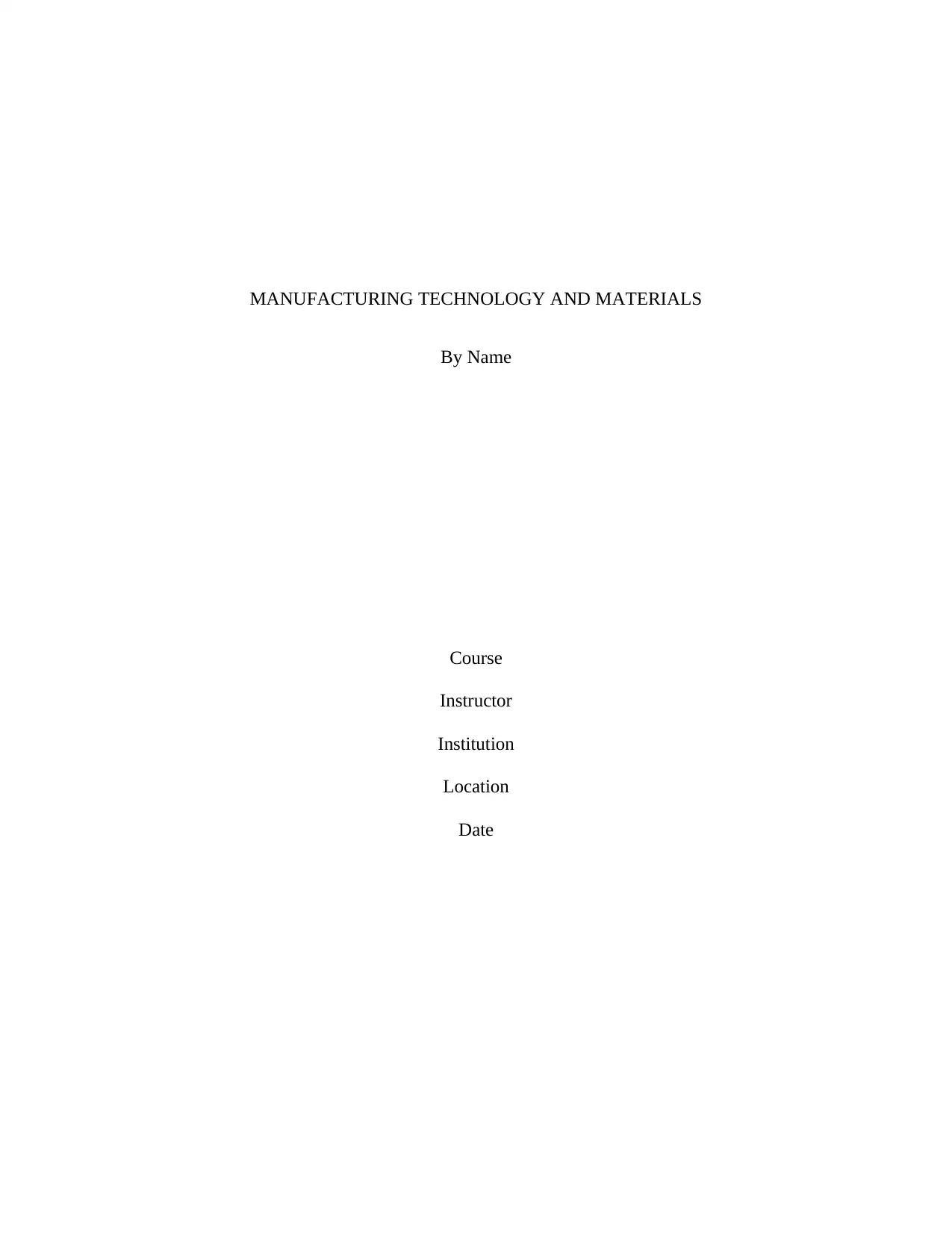
MANUFACTURING TECHNOLOGY AND MATERIALS
By Name
Course
Instructor
Institution
Location
Date
By Name
Course
Instructor
Institution
Location
Date
Paraphrase This Document
Need a fresh take? Get an instant paraphrase of this document with our AI Paraphraser
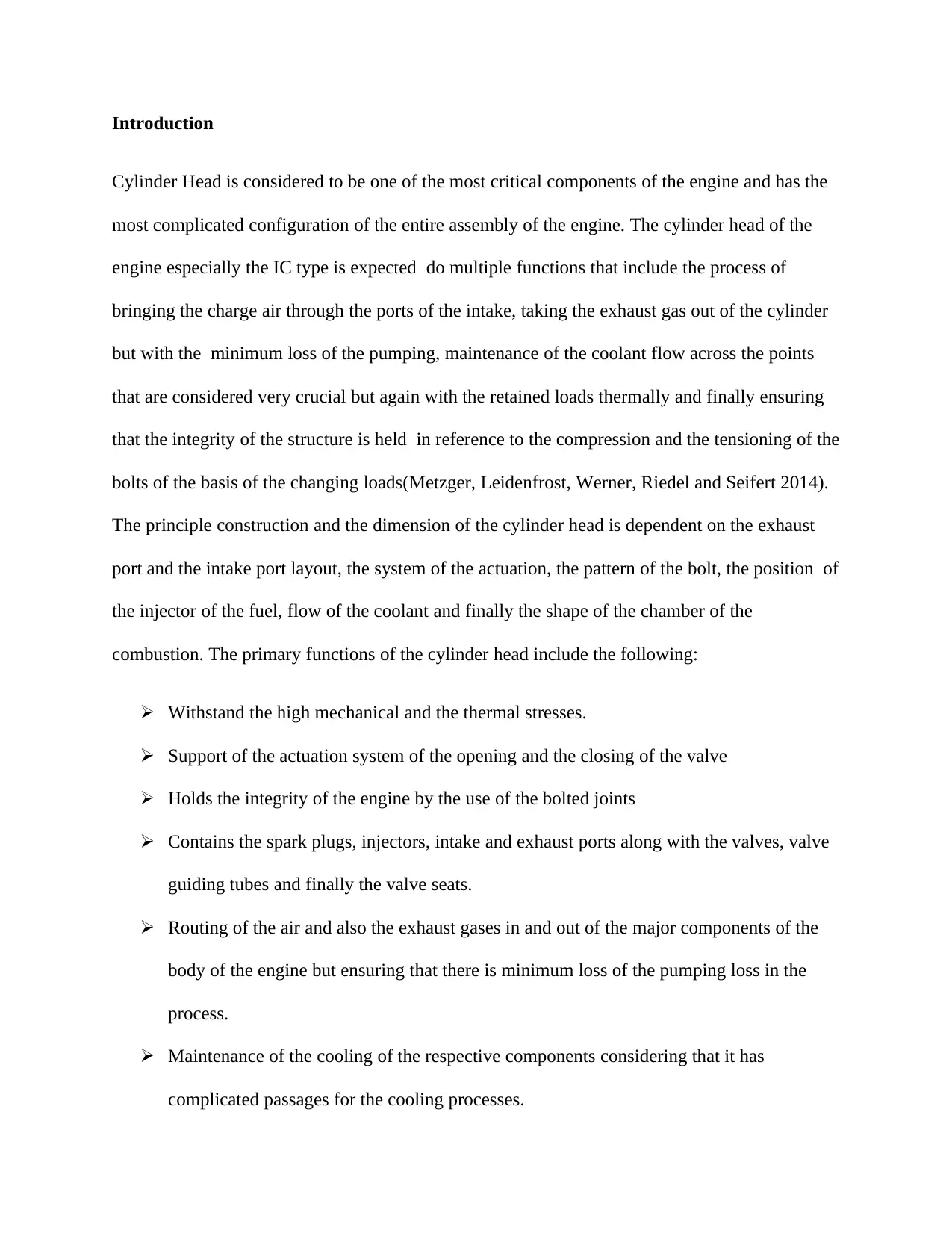
Introduction
Cylinder Head is considered to be one of the most critical components of the engine and has the
most complicated configuration of the entire assembly of the engine. The cylinder head of the
engine especially the IC type is expected do multiple functions that include the process of
bringing the charge air through the ports of the intake, taking the exhaust gas out of the cylinder
but with the minimum loss of the pumping, maintenance of the coolant flow across the points
that are considered very crucial but again with the retained loads thermally and finally ensuring
that the integrity of the structure is held in reference to the compression and the tensioning of the
bolts of the basis of the changing loads(Metzger, Leidenfrost, Werner, Riedel and Seifert 2014).
The principle construction and the dimension of the cylinder head is dependent on the exhaust
port and the intake port layout, the system of the actuation, the pattern of the bolt, the position of
the injector of the fuel, flow of the coolant and finally the shape of the chamber of the
combustion. The primary functions of the cylinder head include the following:
Withstand the high mechanical and the thermal stresses.
Support of the actuation system of the opening and the closing of the valve
Holds the integrity of the engine by the use of the bolted joints
Contains the spark plugs, injectors, intake and exhaust ports along with the valves, valve
guiding tubes and finally the valve seats.
Routing of the air and also the exhaust gases in and out of the major components of the
body of the engine but ensuring that there is minimum loss of the pumping loss in the
process.
Maintenance of the cooling of the respective components considering that it has
complicated passages for the cooling processes.
Cylinder Head is considered to be one of the most critical components of the engine and has the
most complicated configuration of the entire assembly of the engine. The cylinder head of the
engine especially the IC type is expected do multiple functions that include the process of
bringing the charge air through the ports of the intake, taking the exhaust gas out of the cylinder
but with the minimum loss of the pumping, maintenance of the coolant flow across the points
that are considered very crucial but again with the retained loads thermally and finally ensuring
that the integrity of the structure is held in reference to the compression and the tensioning of the
bolts of the basis of the changing loads(Metzger, Leidenfrost, Werner, Riedel and Seifert 2014).
The principle construction and the dimension of the cylinder head is dependent on the exhaust
port and the intake port layout, the system of the actuation, the pattern of the bolt, the position of
the injector of the fuel, flow of the coolant and finally the shape of the chamber of the
combustion. The primary functions of the cylinder head include the following:
Withstand the high mechanical and the thermal stresses.
Support of the actuation system of the opening and the closing of the valve
Holds the integrity of the engine by the use of the bolted joints
Contains the spark plugs, injectors, intake and exhaust ports along with the valves, valve
guiding tubes and finally the valve seats.
Routing of the air and also the exhaust gases in and out of the major components of the
body of the engine but ensuring that there is minimum loss of the pumping loss in the
process.
Maintenance of the cooling of the respective components considering that it has
complicated passages for the cooling processes.
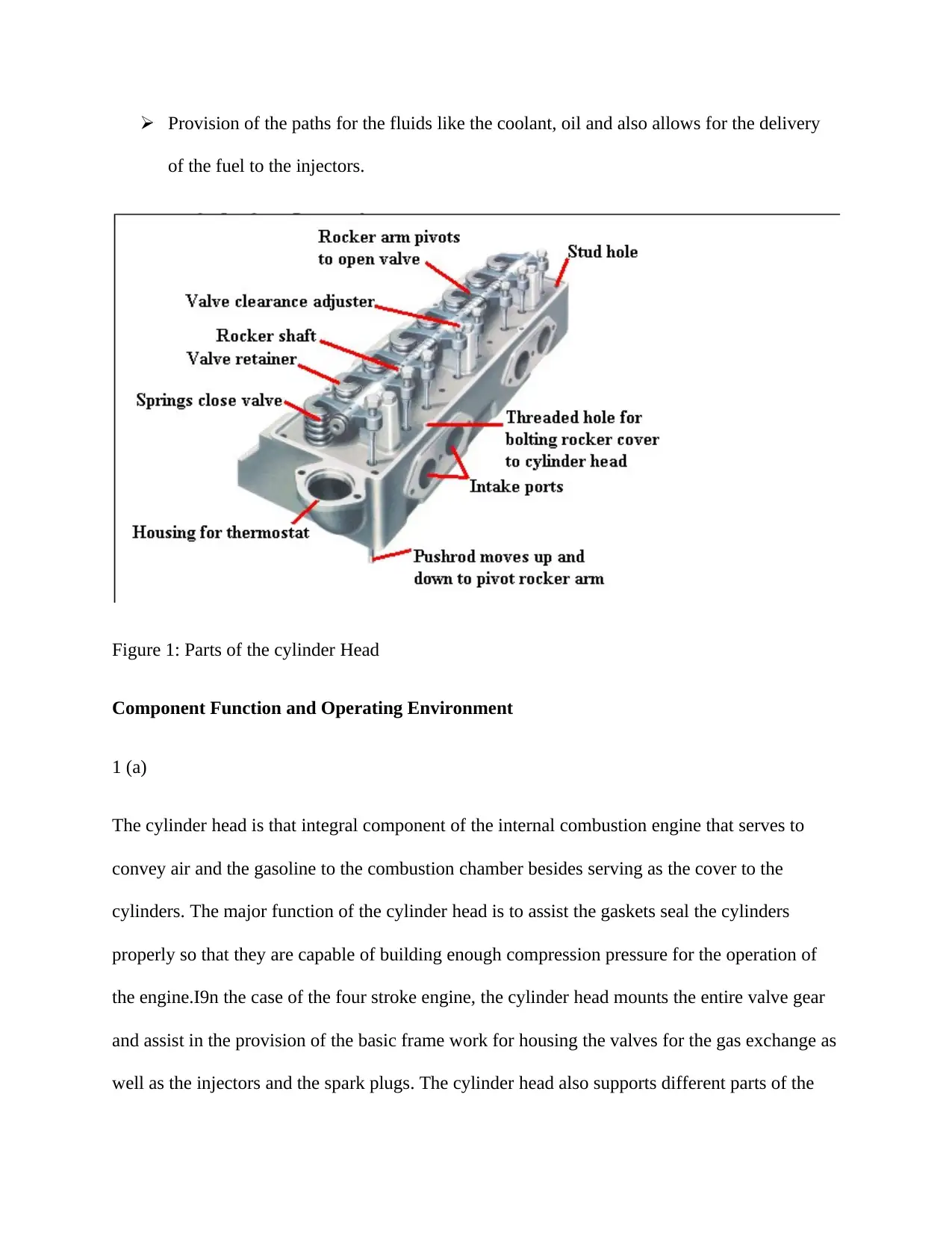
Provision of the paths for the fluids like the coolant, oil and also allows for the delivery
of the fuel to the injectors.
Figure 1: Parts of the cylinder Head
Component Function and Operating Environment
1 (a)
The cylinder head is that integral component of the internal combustion engine that serves to
convey air and the gasoline to the combustion chamber besides serving as the cover to the
cylinders. The major function of the cylinder head is to assist the gaskets seal the cylinders
properly so that they are capable of building enough compression pressure for the operation of
the engine.I9n the case of the four stroke engine, the cylinder head mounts the entire valve gear
and assist in the provision of the basic frame work for housing the valves for the gas exchange as
well as the injectors and the spark plugs. The cylinder head also supports different parts of the
of the fuel to the injectors.
Figure 1: Parts of the cylinder Head
Component Function and Operating Environment
1 (a)
The cylinder head is that integral component of the internal combustion engine that serves to
convey air and the gasoline to the combustion chamber besides serving as the cover to the
cylinders. The major function of the cylinder head is to assist the gaskets seal the cylinders
properly so that they are capable of building enough compression pressure for the operation of
the engine.I9n the case of the four stroke engine, the cylinder head mounts the entire valve gear
and assist in the provision of the basic frame work for housing the valves for the gas exchange as
well as the injectors and the spark plugs. The cylinder head also supports different parts of the
⊘ This is a preview!⊘
Do you want full access?
Subscribe today to unlock all pages.

Trusted by 1+ million students worldwide
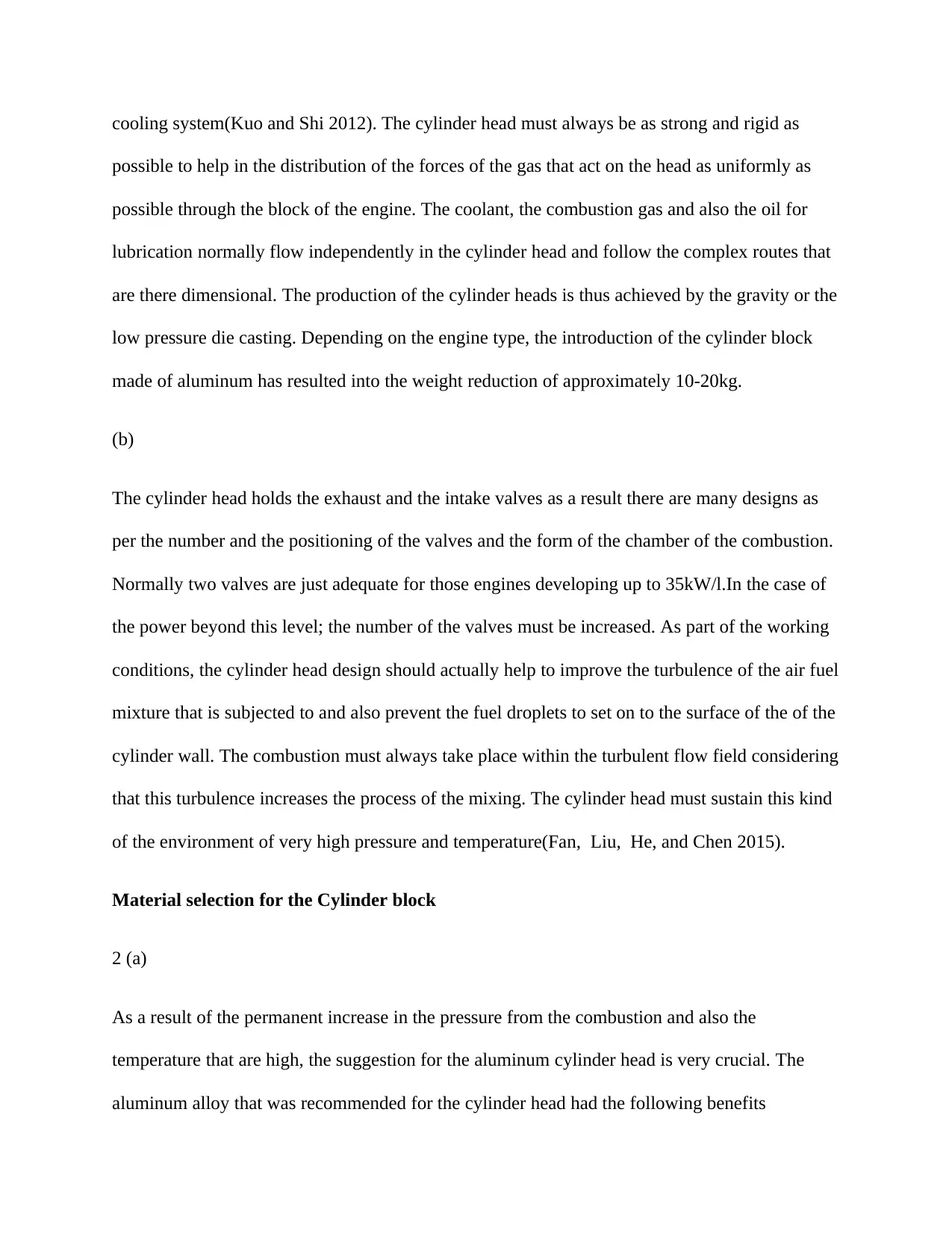
cooling system(Kuo and Shi 2012). The cylinder head must always be as strong and rigid as
possible to help in the distribution of the forces of the gas that act on the head as uniformly as
possible through the block of the engine. The coolant, the combustion gas and also the oil for
lubrication normally flow independently in the cylinder head and follow the complex routes that
are there dimensional. The production of the cylinder heads is thus achieved by the gravity or the
low pressure die casting. Depending on the engine type, the introduction of the cylinder block
made of aluminum has resulted into the weight reduction of approximately 10-20kg.
(b)
The cylinder head holds the exhaust and the intake valves as a result there are many designs as
per the number and the positioning of the valves and the form of the chamber of the combustion.
Normally two valves are just adequate for those engines developing up to 35kW/l.In the case of
the power beyond this level; the number of the valves must be increased. As part of the working
conditions, the cylinder head design should actually help to improve the turbulence of the air fuel
mixture that is subjected to and also prevent the fuel droplets to set on to the surface of the of the
cylinder wall. The combustion must always take place within the turbulent flow field considering
that this turbulence increases the process of the mixing. The cylinder head must sustain this kind
of the environment of very high pressure and temperature(Fan, Liu, He, and Chen 2015).
Material selection for the Cylinder block
2 (a)
As a result of the permanent increase in the pressure from the combustion and also the
temperature that are high, the suggestion for the aluminum cylinder head is very crucial. The
aluminum alloy that was recommended for the cylinder head had the following benefits
possible to help in the distribution of the forces of the gas that act on the head as uniformly as
possible through the block of the engine. The coolant, the combustion gas and also the oil for
lubrication normally flow independently in the cylinder head and follow the complex routes that
are there dimensional. The production of the cylinder heads is thus achieved by the gravity or the
low pressure die casting. Depending on the engine type, the introduction of the cylinder block
made of aluminum has resulted into the weight reduction of approximately 10-20kg.
(b)
The cylinder head holds the exhaust and the intake valves as a result there are many designs as
per the number and the positioning of the valves and the form of the chamber of the combustion.
Normally two valves are just adequate for those engines developing up to 35kW/l.In the case of
the power beyond this level; the number of the valves must be increased. As part of the working
conditions, the cylinder head design should actually help to improve the turbulence of the air fuel
mixture that is subjected to and also prevent the fuel droplets to set on to the surface of the of the
cylinder wall. The combustion must always take place within the turbulent flow field considering
that this turbulence increases the process of the mixing. The cylinder head must sustain this kind
of the environment of very high pressure and temperature(Fan, Liu, He, and Chen 2015).
Material selection for the Cylinder block
2 (a)
As a result of the permanent increase in the pressure from the combustion and also the
temperature that are high, the suggestion for the aluminum cylinder head is very crucial. The
aluminum alloy that was recommended for the cylinder head had the following benefits
Paraphrase This Document
Need a fresh take? Get an instant paraphrase of this document with our AI Paraphraser
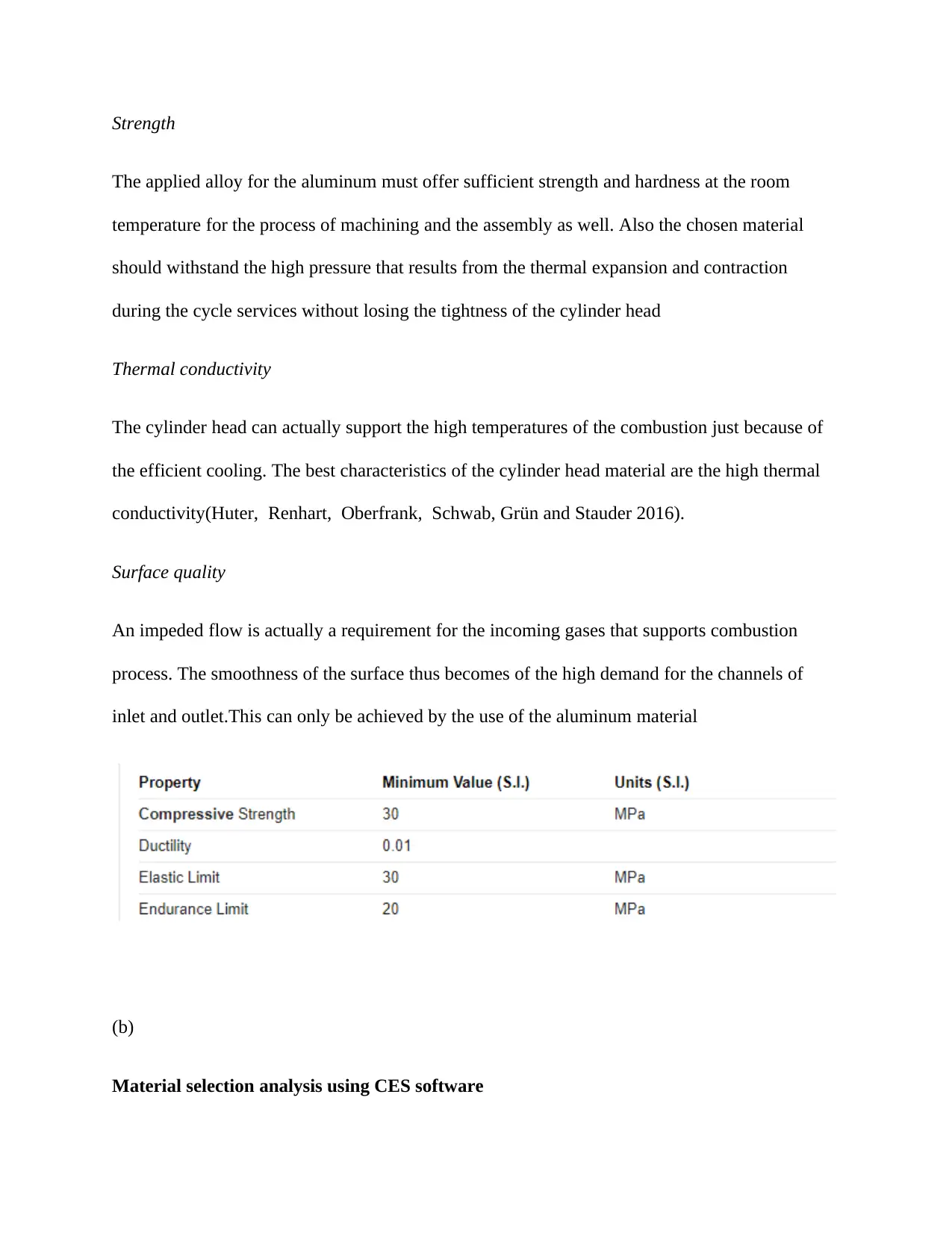
Strength
The applied alloy for the aluminum must offer sufficient strength and hardness at the room
temperature for the process of machining and the assembly as well. Also the chosen material
should withstand the high pressure that results from the thermal expansion and contraction
during the cycle services without losing the tightness of the cylinder head
Thermal conductivity
The cylinder head can actually support the high temperatures of the combustion just because of
the efficient cooling. The best characteristics of the cylinder head material are the high thermal
conductivity(Huter, Renhart, Oberfrank, Schwab, Grün and Stauder 2016).
Surface quality
An impeded flow is actually a requirement for the incoming gases that supports combustion
process. The smoothness of the surface thus becomes of the high demand for the channels of
inlet and outlet.This can only be achieved by the use of the aluminum material
(b)
Material selection analysis using CES software
The applied alloy for the aluminum must offer sufficient strength and hardness at the room
temperature for the process of machining and the assembly as well. Also the chosen material
should withstand the high pressure that results from the thermal expansion and contraction
during the cycle services without losing the tightness of the cylinder head
Thermal conductivity
The cylinder head can actually support the high temperatures of the combustion just because of
the efficient cooling. The best characteristics of the cylinder head material are the high thermal
conductivity(Huter, Renhart, Oberfrank, Schwab, Grün and Stauder 2016).
Surface quality
An impeded flow is actually a requirement for the incoming gases that supports combustion
process. The smoothness of the surface thus becomes of the high demand for the channels of
inlet and outlet.This can only be achieved by the use of the aluminum material
(b)
Material selection analysis using CES software
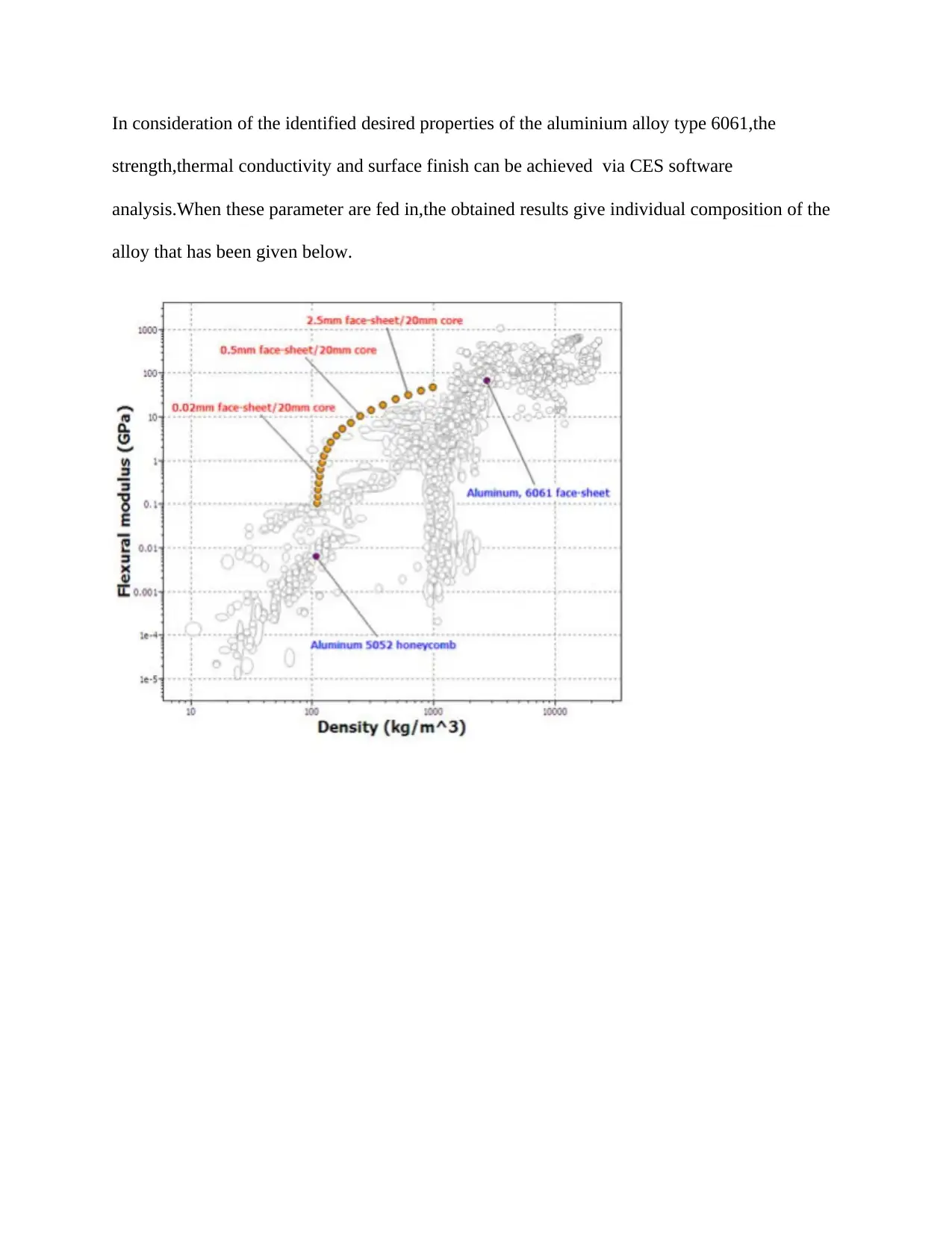
In consideration of the identified desired properties of the aluminium alloy type 6061,the
strength,thermal conductivity and surface finish can be achieved via CES software
analysis.When these parameter are fed in,the obtained results give individual composition of the
alloy that has been given below.
strength,thermal conductivity and surface finish can be achieved via CES software
analysis.When these parameter are fed in,the obtained results give individual composition of the
alloy that has been given below.
⊘ This is a preview!⊘
Do you want full access?
Subscribe today to unlock all pages.

Trusted by 1+ million students worldwide
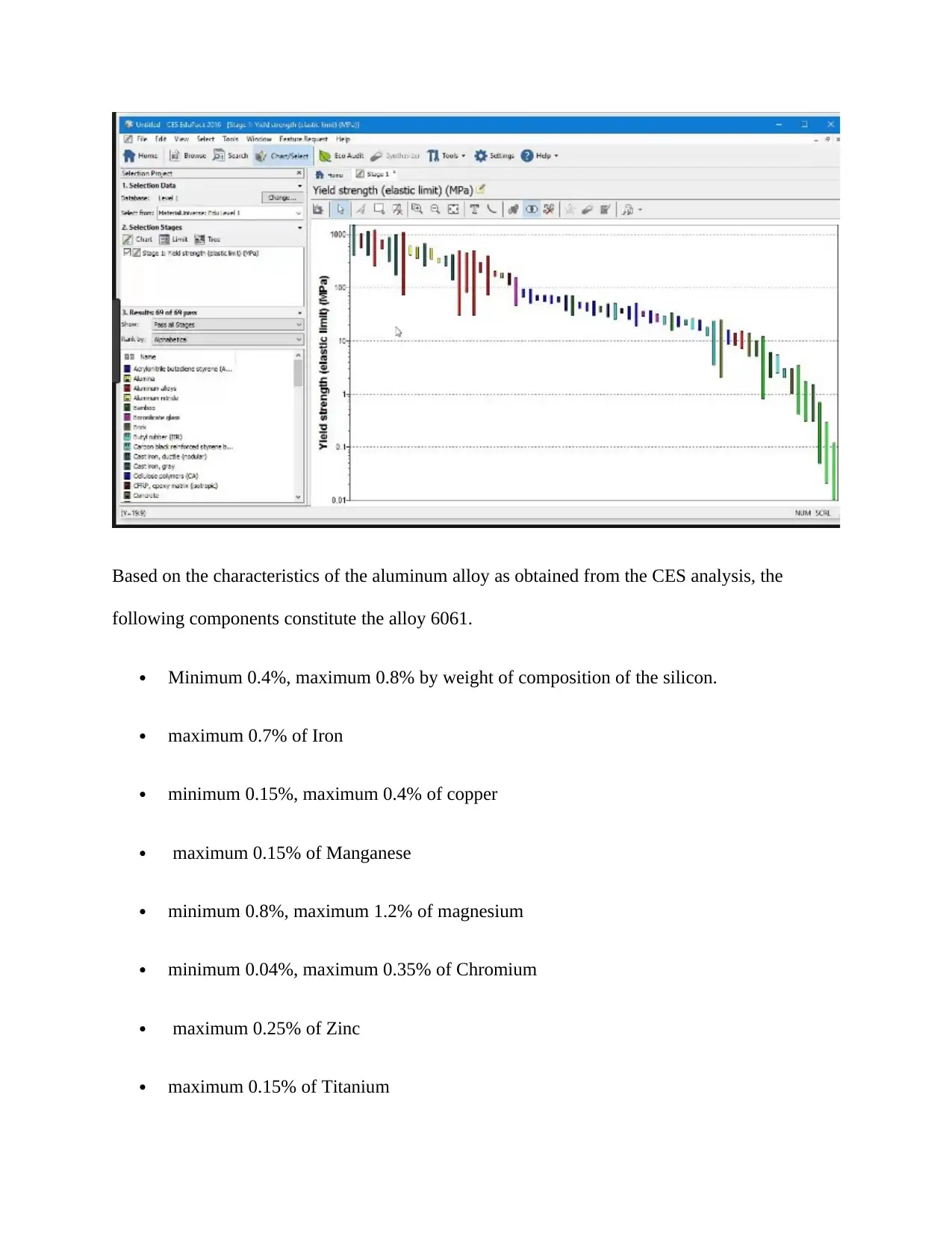
Based on the characteristics of the aluminum alloy as obtained from the CES analysis, the
following components constitute the alloy 6061.
Minimum 0.4%, maximum 0.8% by weight of composition of the silicon.
maximum 0.7% of Iron
minimum 0.15%, maximum 0.4% of copper
maximum 0.15% of Manganese
minimum 0.8%, maximum 1.2% of magnesium
minimum 0.04%, maximum 0.35% of Chromium
maximum 0.25% of Zinc
maximum 0.15% of Titanium
following components constitute the alloy 6061.
Minimum 0.4%, maximum 0.8% by weight of composition of the silicon.
maximum 0.7% of Iron
minimum 0.15%, maximum 0.4% of copper
maximum 0.15% of Manganese
minimum 0.8%, maximum 1.2% of magnesium
minimum 0.04%, maximum 0.35% of Chromium
maximum 0.25% of Zinc
maximum 0.15% of Titanium
Paraphrase This Document
Need a fresh take? Get an instant paraphrase of this document with our AI Paraphraser
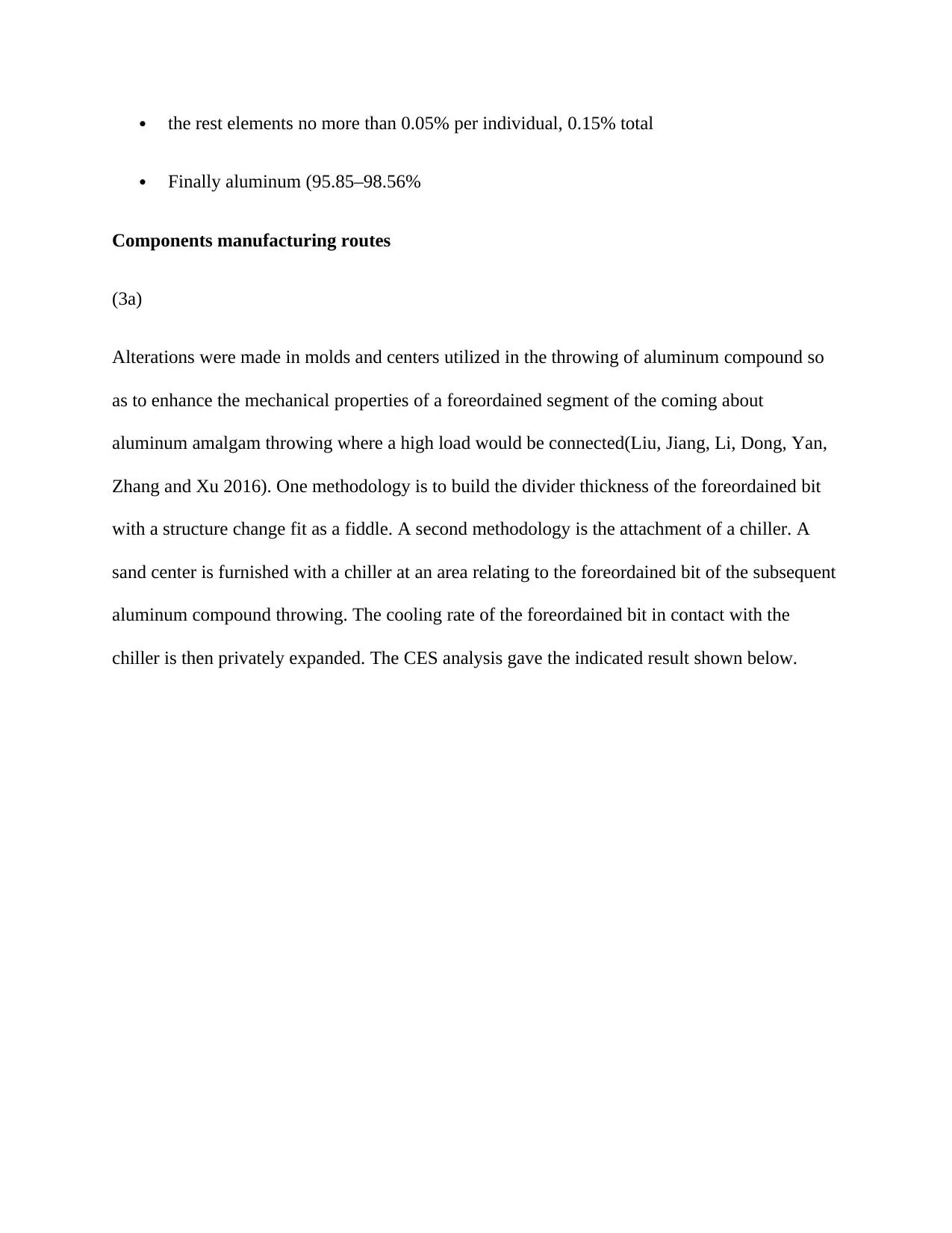
the rest elements no more than 0.05% per individual, 0.15% total
Finally aluminum (95.85–98.56%
Components manufacturing routes
(3a)
Alterations were made in molds and centers utilized in the throwing of aluminum compound so
as to enhance the mechanical properties of a foreordained segment of the coming about
aluminum amalgam throwing where a high load would be connected(Liu, Jiang, Li, Dong, Yan,
Zhang and Xu 2016). One methodology is to build the divider thickness of the foreordained bit
with a structure change fit as a fiddle. A second methodology is the attachment of a chiller. A
sand center is furnished with a chiller at an area relating to the foreordained bit of the subsequent
aluminum compound throwing. The cooling rate of the foreordained bit in contact with the
chiller is then privately expanded. The CES analysis gave the indicated result shown below.
Finally aluminum (95.85–98.56%
Components manufacturing routes
(3a)
Alterations were made in molds and centers utilized in the throwing of aluminum compound so
as to enhance the mechanical properties of a foreordained segment of the coming about
aluminum amalgam throwing where a high load would be connected(Liu, Jiang, Li, Dong, Yan,
Zhang and Xu 2016). One methodology is to build the divider thickness of the foreordained bit
with a structure change fit as a fiddle. A second methodology is the attachment of a chiller. A
sand center is furnished with a chiller at an area relating to the foreordained bit of the subsequent
aluminum compound throwing. The cooling rate of the foreordained bit in contact with the
chiller is then privately expanded. The CES analysis gave the indicated result shown below.
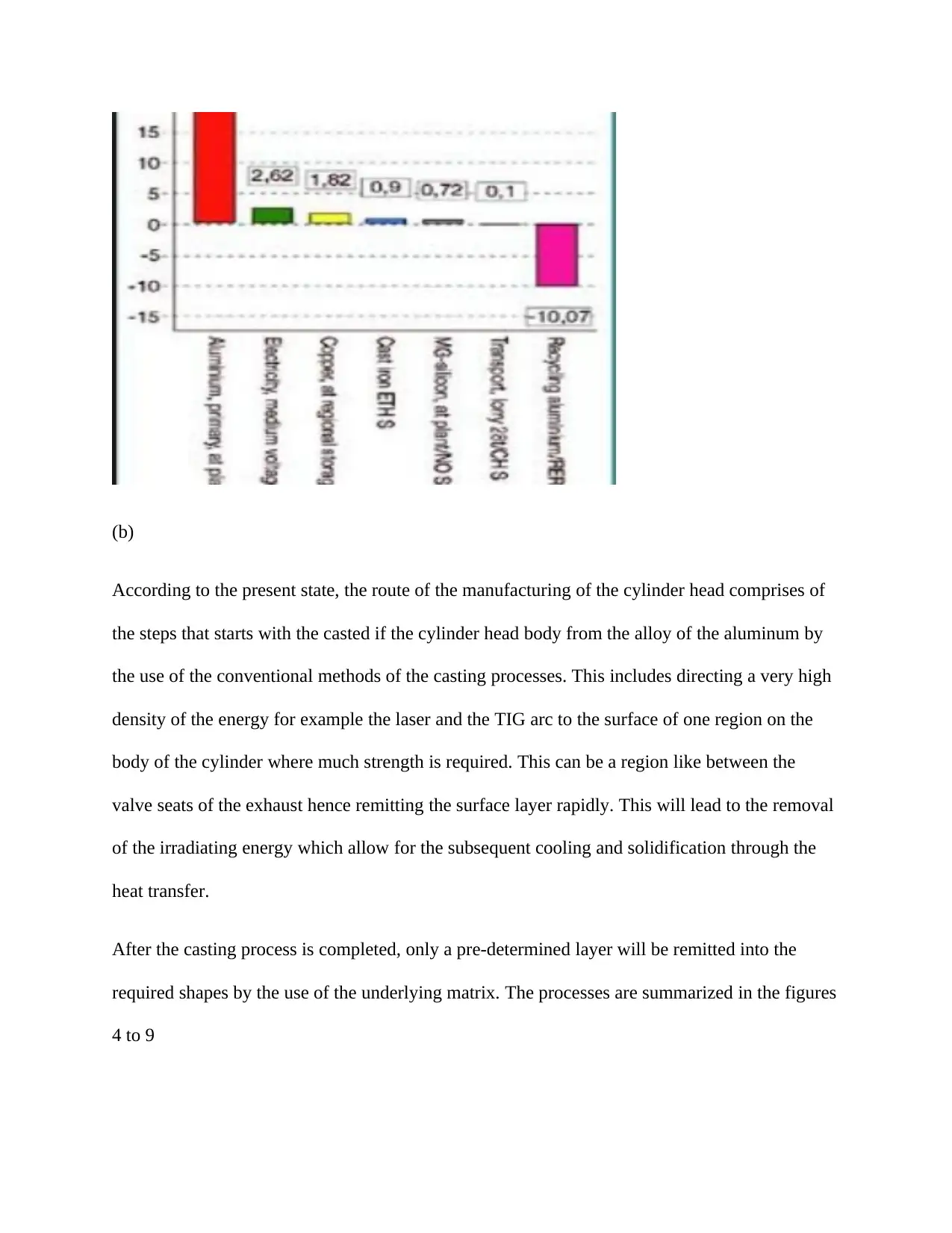
(b)
According to the present state, the route of the manufacturing of the cylinder head comprises of
the steps that starts with the casted if the cylinder head body from the alloy of the aluminum by
the use of the conventional methods of the casting processes. This includes directing a very high
density of the energy for example the laser and the TIG arc to the surface of one region on the
body of the cylinder where much strength is required. This can be a region like between the
valve seats of the exhaust hence remitting the surface layer rapidly. This will lead to the removal
of the irradiating energy which allow for the subsequent cooling and solidification through the
heat transfer.
After the casting process is completed, only a pre-determined layer will be remitted into the
required shapes by the use of the underlying matrix. The processes are summarized in the figures
4 to 9
According to the present state, the route of the manufacturing of the cylinder head comprises of
the steps that starts with the casted if the cylinder head body from the alloy of the aluminum by
the use of the conventional methods of the casting processes. This includes directing a very high
density of the energy for example the laser and the TIG arc to the surface of one region on the
body of the cylinder where much strength is required. This can be a region like between the
valve seats of the exhaust hence remitting the surface layer rapidly. This will lead to the removal
of the irradiating energy which allow for the subsequent cooling and solidification through the
heat transfer.
After the casting process is completed, only a pre-determined layer will be remitted into the
required shapes by the use of the underlying matrix. The processes are summarized in the figures
4 to 9
⊘ This is a preview!⊘
Do you want full access?
Subscribe today to unlock all pages.

Trusted by 1+ million students worldwide

Figure 4 and Figure 5
Figure 6 and Figure 7
Figure 6 and Figure 7
Paraphrase This Document
Need a fresh take? Get an instant paraphrase of this document with our AI Paraphraser
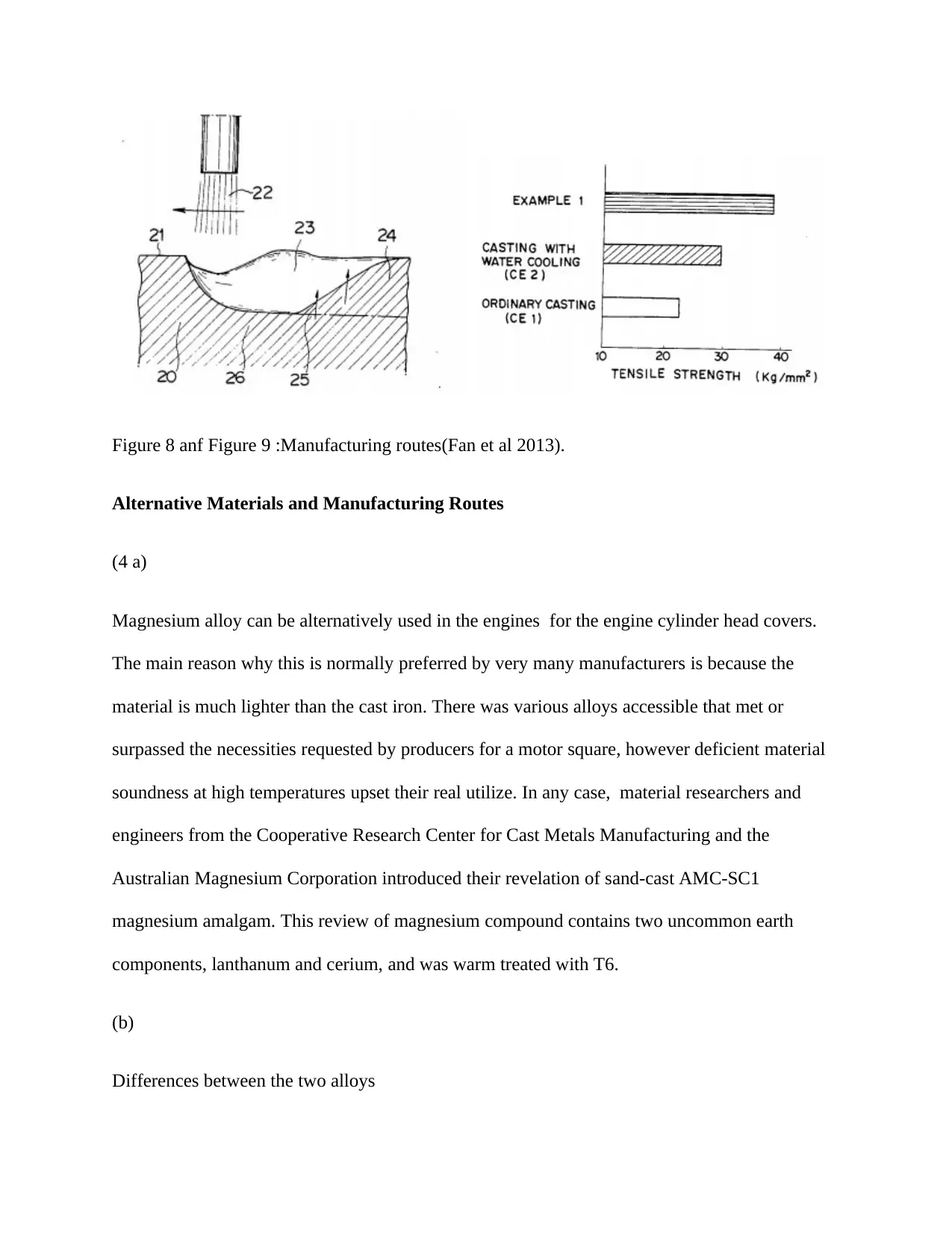
Figure 8 anf Figure 9 :Manufacturing routes(Fan et al 2013).
Alternative Materials and Manufacturing Routes
(4 a)
Magnesium alloy can be alternatively used in the engines for the engine cylinder head covers.
The main reason why this is normally preferred by very many manufacturers is because the
material is much lighter than the cast iron. There was various alloys accessible that met or
surpassed the necessities requested by producers for a motor square, however deficient material
soundness at high temperatures upset their real utilize. In any case, material researchers and
engineers from the Cooperative Research Center for Cast Metals Manufacturing and the
Australian Magnesium Corporation introduced their revelation of sand-cast AMC-SC1
magnesium amalgam. This review of magnesium compound contains two uncommon earth
components, lanthanum and cerium, and was warm treated with T6.
(b)
Differences between the two alloys
Alternative Materials and Manufacturing Routes
(4 a)
Magnesium alloy can be alternatively used in the engines for the engine cylinder head covers.
The main reason why this is normally preferred by very many manufacturers is because the
material is much lighter than the cast iron. There was various alloys accessible that met or
surpassed the necessities requested by producers for a motor square, however deficient material
soundness at high temperatures upset their real utilize. In any case, material researchers and
engineers from the Cooperative Research Center for Cast Metals Manufacturing and the
Australian Magnesium Corporation introduced their revelation of sand-cast AMC-SC1
magnesium amalgam. This review of magnesium compound contains two uncommon earth
components, lanthanum and cerium, and was warm treated with T6.
(b)
Differences between the two alloys
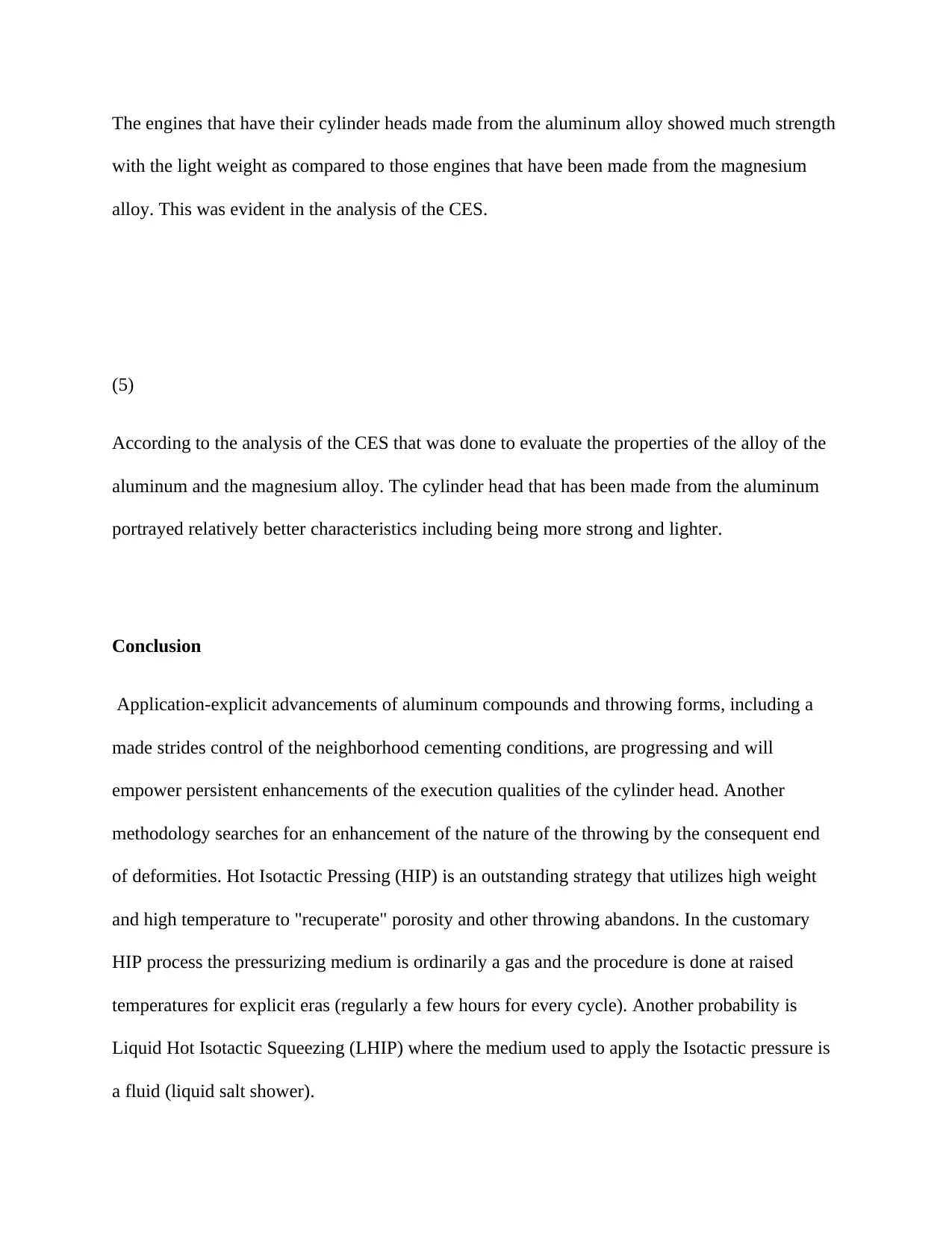
The engines that have their cylinder heads made from the aluminum alloy showed much strength
with the light weight as compared to those engines that have been made from the magnesium
alloy. This was evident in the analysis of the CES.
(5)
According to the analysis of the CES that was done to evaluate the properties of the alloy of the
aluminum and the magnesium alloy. The cylinder head that has been made from the aluminum
portrayed relatively better characteristics including being more strong and lighter.
Conclusion
Application-explicit advancements of aluminum compounds and throwing forms, including a
made strides control of the neighborhood cementing conditions, are progressing and will
empower persistent enhancements of the execution qualities of the cylinder head. Another
methodology searches for an enhancement of the nature of the throwing by the consequent end
of deformities. Hot Isotactic Pressing (HIP) is an outstanding strategy that utilizes high weight
and high temperature to "recuperate" porosity and other throwing abandons. In the customary
HIP process the pressurizing medium is ordinarily a gas and the procedure is done at raised
temperatures for explicit eras (regularly a few hours for every cycle). Another probability is
Liquid Hot Isotactic Squeezing (LHIP) where the medium used to apply the Isotactic pressure is
a fluid (liquid salt shower).
with the light weight as compared to those engines that have been made from the magnesium
alloy. This was evident in the analysis of the CES.
(5)
According to the analysis of the CES that was done to evaluate the properties of the alloy of the
aluminum and the magnesium alloy. The cylinder head that has been made from the aluminum
portrayed relatively better characteristics including being more strong and lighter.
Conclusion
Application-explicit advancements of aluminum compounds and throwing forms, including a
made strides control of the neighborhood cementing conditions, are progressing and will
empower persistent enhancements of the execution qualities of the cylinder head. Another
methodology searches for an enhancement of the nature of the throwing by the consequent end
of deformities. Hot Isotactic Pressing (HIP) is an outstanding strategy that utilizes high weight
and high temperature to "recuperate" porosity and other throwing abandons. In the customary
HIP process the pressurizing medium is ordinarily a gas and the procedure is done at raised
temperatures for explicit eras (regularly a few hours for every cycle). Another probability is
Liquid Hot Isotactic Squeezing (LHIP) where the medium used to apply the Isotactic pressure is
a fluid (liquid salt shower).
⊘ This is a preview!⊘
Do you want full access?
Subscribe today to unlock all pages.

Trusted by 1+ million students worldwide
1 out of 14
Related Documents
Your All-in-One AI-Powered Toolkit for Academic Success.
+13062052269
info@desklib.com
Available 24*7 on WhatsApp / Email
![[object Object]](/_next/static/media/star-bottom.7253800d.svg)
Unlock your academic potential
Copyright © 2020–2025 A2Z Services. All Rights Reserved. Developed and managed by ZUCOL.





